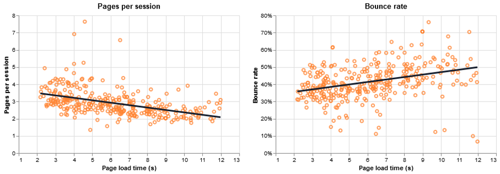Why website speed matters in 2021
Beyond the direct effect your website's speed has on your Google rankings, websites with longer load times tend to have higher bounce rates and lower conversion rates, making page load time one of the most important user experience metrics on your website.

Page speed is not a new concept. Google has used it as a ranking factor in search results since 2010, and since then page and site speed has become increasingly important, and not just from a ranking perspective. Visitors to hotel websites expect fast pages and if you aren’t turning visitors into customers, one reason could be slow loading page times. Optimizing your page load time is a good way to help users get where they're going faster and happier, curb your bounce rate and convert more bookings.
HOW PAGE LOAD TIME AFFECTS CUSTOMER BEHAVIOUR
Using data from our 400+ hotel database, we've established that there is a correlation between page load time and a number of user experience related metrics. The most significant can be measured between page load time and a metric called pages per session. Pages per session is a metric that tells you how many pages on average a user sees during one visit to your website. You probably put a lot of time and effort into crafting the content on your website, because you know that the right content directly affects your bottom line.
Our research shows that if your website is slow to load, visitors will visit less pages, leaving your site before they have a chance to explore it in depth.

Another significant relationship from our hotel data that can be observed is between page load time and a metric called bounce rate. Bounce rate is the percentage of visitors who only visit one page of your website and then leave your website immediately. We can see that slower websites tend to have higher bounce rates, meaning that some visitors simply lose their patience and refuse to interact with a website that takes a long time to load. If these customers decide they want to stay with you, they might book via an OTA instead of booking direct, or worse move on to a competitor’s website, where they book.
It is obvious that website speed has a direct impact on customer experience. Our research has also uncovered a statistically significant, albeit weaker relationship between website speed and conversion rates, proving that a slow website can directly affect your bottom line.
BEYOND SIMPLE PAGE SPEED - CORE WEB VITALS
A slow website doesn't just jeopardise your customers' experience, it also has an effect on your Google rankings. Google takes page speed into account when deciding how to rank your website on their search page and is expected to put even more emphasis on it soon.
In May 2021 Google is expected to roll out a new Core Algorithm Update, tweaking how pages are ranked on Google search. The new algorithm will consider, among other metrics, new Core Web Vitals – a list of technical SEO metrics designed to improve user experience. In among this list are new ways to think about and measure page speed. These new factors are called ‘page experience metrics’ and in addition to mobile friendliness, safe browsing, https and no intrusive interstitials, here are the three you will need to think about:
- Largest Contentful Paint (LCP) LCP measures when page-to-page navigation appears complete to a website user, or in more technical terms the render time of the largest image or text block. Google’s recommendation is to keep LCP under 2.5 seconds for 75% of page loads.
- First Input Delay (FIP)FID measures the reaction time of a page to the first user input – this could be the user pressing, tapping or clicking a key or mouse. If a webpage looks like it has finished loading but nothing on the page is responsive this means the page has a high FID time. You should aim for an FID under 100 milliseconds for at least 75% of your pages.
- Cumulative Layout Shift (CLS) less than 0.1 for 75% of page loads)A slow CLS is identified when a user loads a new page and tries to click a button, but the page moves due to an error in the loading process.
In summary, if your website is slow, not only does your customer experience suffer, but Google will also penalize you by not displaying your website as high up on their results page as it could be.
HOW TO MEASURE CORE WEB VITALS AND PAGE SPEED
One way to gain an understanding of how your site is performing in respect of loading speeds is by using tools like Google's Page Speed Insights (PSI) which reports on the performance of a page on desktop and mobile devices along with suggestions for how it can be improved. PSI provides a score which summarises the page’s performance, which is great to keep track of how changes to your website affect its speed.
As well as using tools like Google’s, competitor mapping and comparing your average page speeds against other hotels can be useful. Hotel Benchmark helps to provide competitive landscape analysis when looking at your site’s average page loading times, bounce rates and conversion rates as well as isolating these by device.
Have you seen better conversions or rankings after improving the loading speed of your website? Please share your experience with us on LinkedIn or Twitter.
Categories:
Jan is Hotel Benchmark's lead developer and a data enthusiast who loves to automate the boring stuff and solve marketing problems using the latest technology. He currently focuses on Google Cloud and Marketing platforms to help hotels understand their marketing data.


